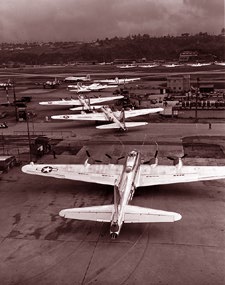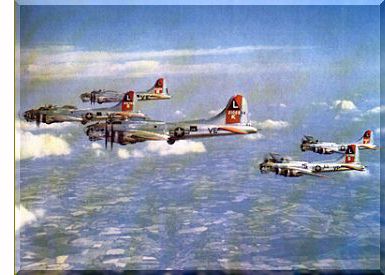

Le Bombardier Boeing B-17, du fait de ses 12 mitrailleuses lourdes, de sa vitesse de 317 km/h et de son fuselage acier, a été surnommé "Forteresse Volante de 15 tonnes" et a par la suite conservé se surnom de "Forteresse Volante". Capable de voler à 8300 mètres d'altitude grace à ses moteurs compressés, le premier B-17 se pose sur le sol britannique le 1er juillet 1942. La première opération européenne de l'US Bomber Group a lieu le 17 aout 1942 et fût un succès total. Suite au raid de Lille du 9 octobre 1942 (107 bombardiers engagés), on ajoute une tourelle avant au B-17. Ce version, le B-17G, sera celle la plus produite. Le 17 aout 1943 aura lieu un raid sur l'Allemagne avec 100 bombardiers perdus. Le 14 octobre 1943, le Bomber Group perdra 88 bombardiers, c'est le "jeudi noir". le taux de pertes était de 4%. Le premier équipage à avoir effectué les 25 missions qui donnaient droit à une permission aux Etats-Unis fut celui du Memphis Belle, qui est depuis resté célèbre.
A compter du 6 juin 1944, le Bomber Group volera 78 jours sur 92 participant à la victoire alliée.
The B-17 Flying Fortress was perhaps the most well-known
American heavy bomber of the Second World War. It achieved a fame far beyond
that of its more numerous stablemate, the Consolidated B-24 Liberator.
A total of 12,677 Fortresses was built before production came to an end.
In August of 1944, the B-17 equipped no less than 33 overseas combat groups. The B-17 was to achieve lasting fame in the daylight precision-bombing campaign over Germany in 1943, 1944 and 1945. It achieved a reputation as being capable of absorbing a tremendous amount of battle damage and still continuing to fly. In later variants, it had an exceptionally-heavy defensive armament. It had an excellent high-altitude performance. It was able to win the affection of the crews who flew in it, since it was often able to bring them home safely when other aircraft would have fallen. However, the B-17 generally had a performance inferior to that of its B-24 stablemate and it could not carry nearly as large a bomb load. In typical missions over Europe, B-17s usually carried a bombload only as large as that which a twin-engined Mosquito could carry.
B-17s dropped 640,036 tons of bombs on European targets
during the war, as compared to 452,508 tons dropped by the Liberator and
463,544 tons dropped by all other US aircraft. Boeing records claim that
the Fortress destroyed 23 enemy aircraft per thousand sorties as compared
to 22 for Liberators, eleven by US fighters, and 3 by all US light and
medium bombers. However, the "kill" claims by both Fortress and Liberator
gunner crews are probably greatly exaggerated, largely because the same
enemy aircraft was being fired at by many different people. Approximately
4750 B-17s were lost on combat missions, which is about one out of three
of all B-17s built.
About the B-17 in German Luftwaffe
...

The B-17G
The B-17G was introduced onto the Fortress production
line in July of 1943, and was destined to be produced in larger numbers
than any other Fortress variant. The most readily-noticeable innovation
introduced by the B-17G was the power-operated Bendix turret mounted in
a chin-type installation underneath the nose. This turret was equipped
with two 0.50-inch machine guns. This installation had first been tested
in combat by the YB-40 and was found to be the only viable innovation introduced
by the unsuccessful escort Fortress. Another innovation introduced by the
G was having the waist guns being permanently enclosed behind windows instead
of being mounted behind removable hatches. This made the rear fuselage
somewhat less drafty. The cheek nose guns introduced on the late B-17F
were retained, but were staggered so that the left gun was in the forward
side window and the right gun was in the middle side window, which reversed
the positions used on the late Fs. The cheek gun mounts bulged somewhat
outward into the airstream, which helped to improve the forward view from
the cheek gun positions. The forward chin installation and the associated
cheek guns were first tested out on B-17F-115-BO 42-30631. Originally,
the Bendix turret was to be introduced on the Boeing production line with
F-135, but the changes were sufficient to justify a new series letter,
and the F-135s became G-1. The B-17G now had the defensive firepower of
no less than thirteen 0.50-inch machine guns -- two chin guns, two cheek
guns, two guns in the dorsal turret, two guns in the ventral turret, two
guns in the waist, two guns in the tail and one gun in the roof of the
radio operator's position. B-17Gs were built by all three members of the
"B.V.D." production pool, with the Boeing lots ranging from production
blocks G-1 to G-110, the Douglas blocks ranging from -5 to -95, and the
Lockheed-Vega blocks ranging from -1 to -110. The B-17G entered service
with the Eighth and Fifteenth Air Forces in late 1943. Camouflage paint
was deleted from production B-17Gs starting in January of 1944. B-17Gs
were delivered in natural metal finish starting in (but not at the beginning)
of production blocks G-35-BO (Boeing), G-20-VE (Lockheed-Vega), and G-35-DL
(Douglas-Long Beach). The so-called "Cheyenne" tail gun mounting modifications
were incorporated in the B-17G-80-BO, -45-DL, -35-VE and subsequent batches.
These tail gun mountings also had a reflector gunsight instead of the previous
ring and bead. With this installation, these B-17Gs were five inches shorter
than the earlier versions. On later production versions, it was found necessary
to stagger the waist gun positions so that the two gunners would not get
in each other's way. On the last production batches (B-17G-105 and -110-BO,
B-17G-75 to -85-DL, and B-17G-85 to -110-VE), the radio compartment gun
was not installed. The ammunition capacity of the waist guns was increased
to 600 rpg. When production terminated in 1945, a total of 4035 B-17Gs
had been built by Boeing, 2395 by Douglas and 2250 by Lockheed-Vega. The
last Boeing-built B-17G was delivered on April 13, 1945. B-17G-1-VE 42-38940
was redesignated XB-17G when assigned to test work. It was not a prototype

Technical Informations about the B-17.G (like the Pink
Lady)
Powerplant: Four Wright R-1820-97 Cyclone radials with
general Electric B-22 turbosuperchargers, each rated at 1200 hp for takeoff
and 1000 hp at 25,000 feet, with a war emergency power of 1380 hp at 26,700
feet. Performance: Maximum speed 263 mph at 25,000 feet, 300 mph at 30,000
feet (war emergency). Cruising speed 150 mph at 25,000 feet. Landing speed
90 mph. Initial climb rate 900 feet per minute. An altitude of 20,000 feet
could be attained in 37 minutes. Service ceiling 35,000 feet. Range 1850
miles with 4000 pounds of bombs at 25,000 feet with 2810 gallons of fuel.
Dimensions: Wingspan 103 feet 9 3/8 inches, length 74 feet 9 inches, height
19 feet 1 inch, wing area 1420 square feet. Weights: 32,720 pounds empty,
55,000 pounds normal loaded, 72,000 pounds maximum. Normal fuel load was
2520 US gallons, but extra fuel tanks could be installed which raised total
fuel capacity to 3612 US gallons. Armament: Specified defensive armament
was as follows: thirteen 0.5-inch Browning machine guns in chin, nose,
dorsal, center-fuselage, ventral, waist and tail positions. Maximum short-range
bombload was 17,600 pounds.
